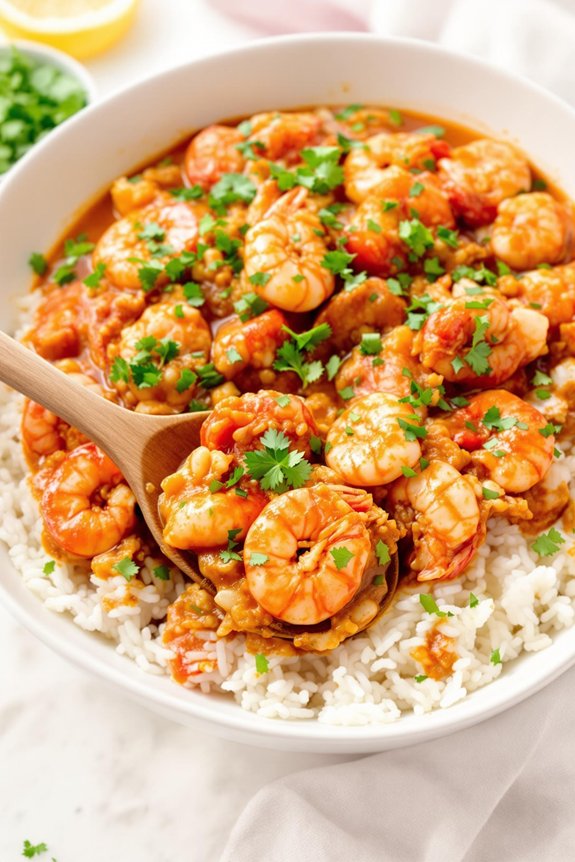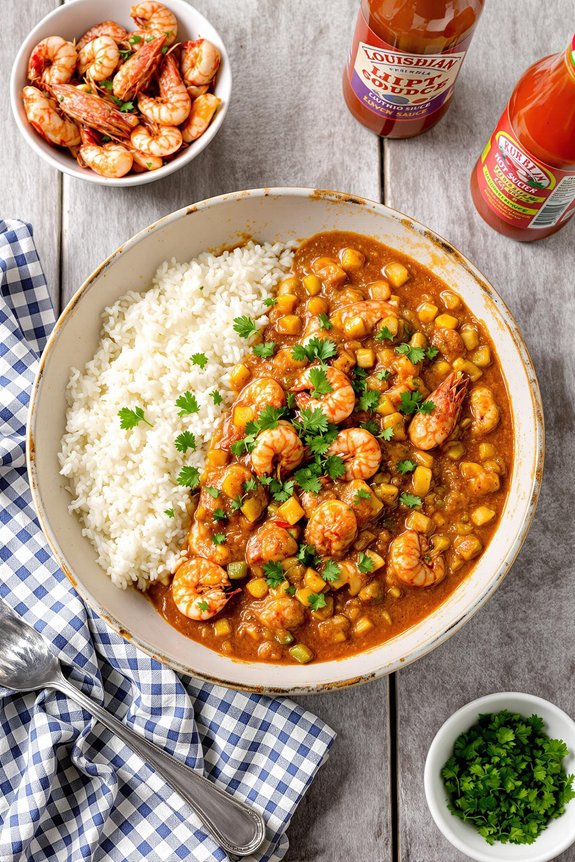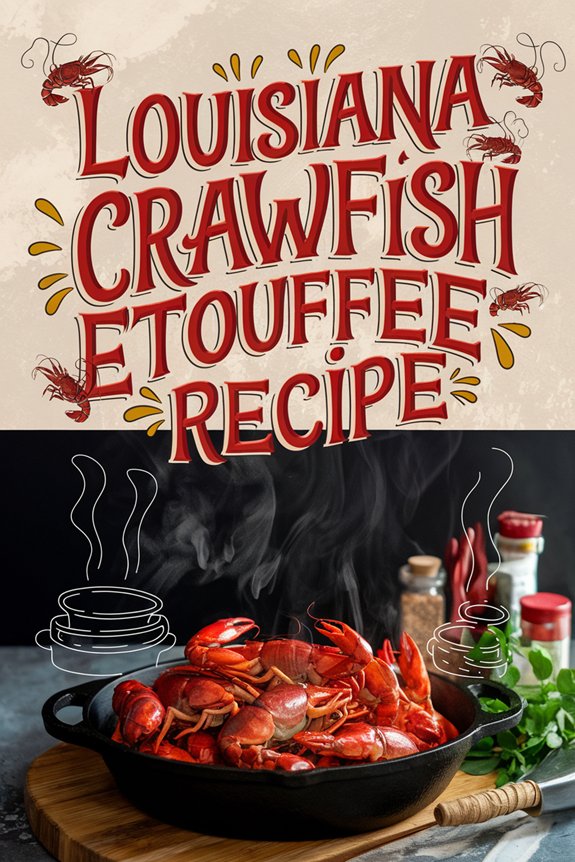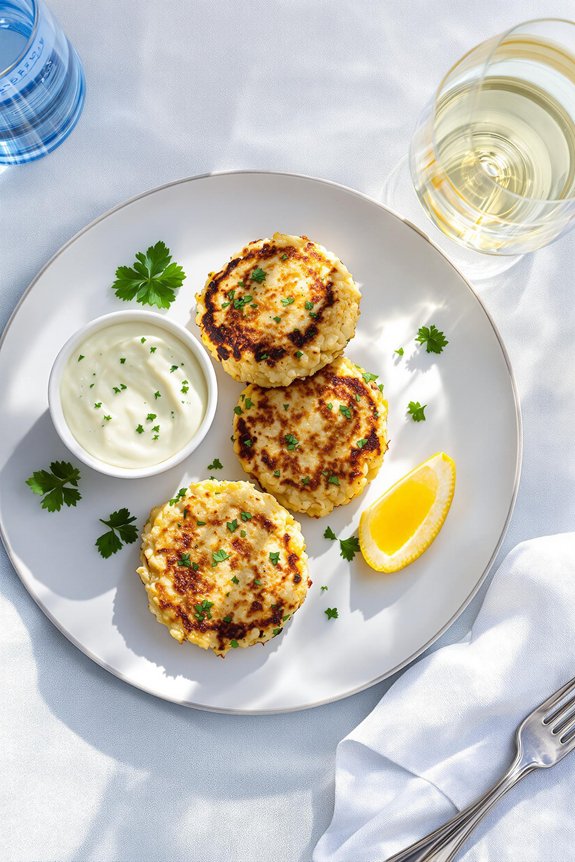Why You’ll Love this Louisiana Crawfish Etouffee
Southern comfort on a plate, that’s what this crawfish etouffee delivers with every single bite. The rich, buttery sauce clings perfectly to each tender morsel of crawfish, creating that unmistakable Cajun flavor profile you’ve been craving.
I’m particularly fond of how the holy trinity of onions, peppers, and celery creates the foundation for this dish.
Can you imagine the aroma that fills your kitchen? Divine.
The best part? It’s surprisingly simple to prepare, taking just minutes once your ingredients are prepped.
Perfect for weeknight dinners or impressing weekend guests, no culinary degree required.
What Ingredients are in Louisiana Crawfish Etouffee?
The heart and soul of any great crawfish etouffee lies in its perfectly balanced ingredients. Traditional Louisiana etouffee starts with a butter-based roux that becomes the canvas for the “holy trinity” of Cajun cooking—onions, bell peppers, and celery.
When these aromatics combine with creamy butter and succulent crawfish tails, they create that distinctively rich, deeply satisfying flavor that makes this dish a true Southern classic.
- 8 tablespoons (1 stick) butter
- 1 large yellow onion, diced
- 1 large green pepper, diced
- 2 stalks celery, diced
- Fresh garlic, minced (to taste)
- 1 pound crawfish tails, with fat
- Salt, cayenne, and black pepper (to taste)
- 1/2 cup water
- 2 tablespoons cornstarch
- Fresh parsley, chopped (for garnish)
- Cooked rice (for serving)
A few notes about these ingredients—the crawfish fat (sometimes called “yellow butter”) is absolutely crucial for authentic flavor, so don’t rinse it away.
Many Louisiana cooks insist that using packaged, pre-cooked crawfish tails is perfectly acceptable, and often preferable to struggling with fresh ones at home.
The cornstarch serves as our thickener rather than a traditional flour-based roux, making this a somewhat lighter version that still delivers that velvety texture we all crave.
And remember, the seasoning is entirely customizable—some like it mild, others like it spicy enough to make your eyebrows sweat. You do you.
How to Make this Louisiana Crawfish Etouffee

Making crawfish etouffee is actually much simpler than its rich, complex flavor might suggest. Start by melting 8 tablespoons (that’s one whole stick) of butter in a heavy saucepan over medium heat. Once melted, add 1 large diced yellow onion, 1 large diced green pepper, and 2 stalks of diced celery—this holy trinity forms the backbone of so many Louisiana classics.
Sauté these aromatics until the onions become transparent and start to take on a slight golden hue, about 5-7 minutes. Your kitchen should already be smelling pretty magnificent at this point.
Now comes the star of our show—add 1 pound of crawfish tails with all that precious fat still clinging to them. Toss in your minced fresh garlic (and honestly, who ever regretted adding too much garlic?), and season generously with salt, cayenne, and black pepper to taste.
While this simmers and the flavors begin to meld, grab a small bowl and dissolve 2 tablespoons of cornstarch in 1/2 cup of cold water, stirring until smooth. Pour this slurry into your crawfish mixture and stir continuously until everything thickens beautifully, which happens surprisingly quickly—usually within just a minute or two.
Remember that the crawfish tails come pre-cooked, so you’re really just heating them through. Overcooking will make them tough and rubbery, which would be a culinary tragedy of the highest order.
To serve this Louisiana masterpiece properly, spoon it generously over hot, fluffy cooked rice, and finish with a sprinkle of fresh chopped parsley. The bright green specks aren’t just pretty—they add a fresh, herbaceous note that cuts through the richness perfectly.
Some folks like to add a dash of hot sauce at the table, while others prefer to let the natural flavors shine. For authentic restaurant-quality results, consider preparing this dish using a professional wok station which provides the high, consistent heat that truly elevates Cajun cooking. When you take that first bite, with the velvety sauce coating each grain of rice and those tender crawfish morsels, you’ll understand why etouffee has been delighting Louisiana palates for generations.
Louisiana Crawfish Etouffee Substitutions and Variations
While crawfish remains the authentic star of this classic Cajun dish, I understand that not everyone can access fresh Louisiana crawfish year-round. Shrimp makes an excellent substitute—just add them later in the cooking process since they cook quickly. Raw, peeled shrimp work best.
You can also try crabmeat or even chicken for a completely different spin. The holy trinity (onions, celery, pepper) is non-negotiable, but you might experiment with adding tomatoes for a Creole twist.
Some cooks prefer a roux base instead of cornstarch for thickening. Different, but equally delicious.
What to Serve with Louisiana Crawfish Etouffee
Although etouffee stands perfectly fine on its own, complementing your rich, spicy crawfish dish with the right sides can elevate your entire meal experience.
I’m partial to serving a simple green salad with a light vinaigrette to cut through the richness. Crusty French bread is non-negotiable in my book—perfect for sopping up that decadent sauce.
For beverages, consider an ice-cold Abita beer or sweet tea.
And if you’re feeling ambitious, why not start with some hush puppies or fried green tomatoes? Southern comfort food deserves proper company, don’t you think?
Final Thoughts
From the moment you take your first bite of this crawfish etouffee, you’ll understand why it’s a Louisiana treasure.
The buttery richness combined with the delicate sweetness of crawfish creates something truly magical in your mouth.
I can’t emphasize enough how important it’s to include that crawfish fat—it’s where so much flavor hides.
Remember, respect the crawfish by not overcooking it. Those tails deserve gentle warming, nothing more.
This dish brings people together around the table, telling stories and savoring each spoonful.
Isn’t that what good food should do? Simple ingredients, transformed into something extraordinary.





